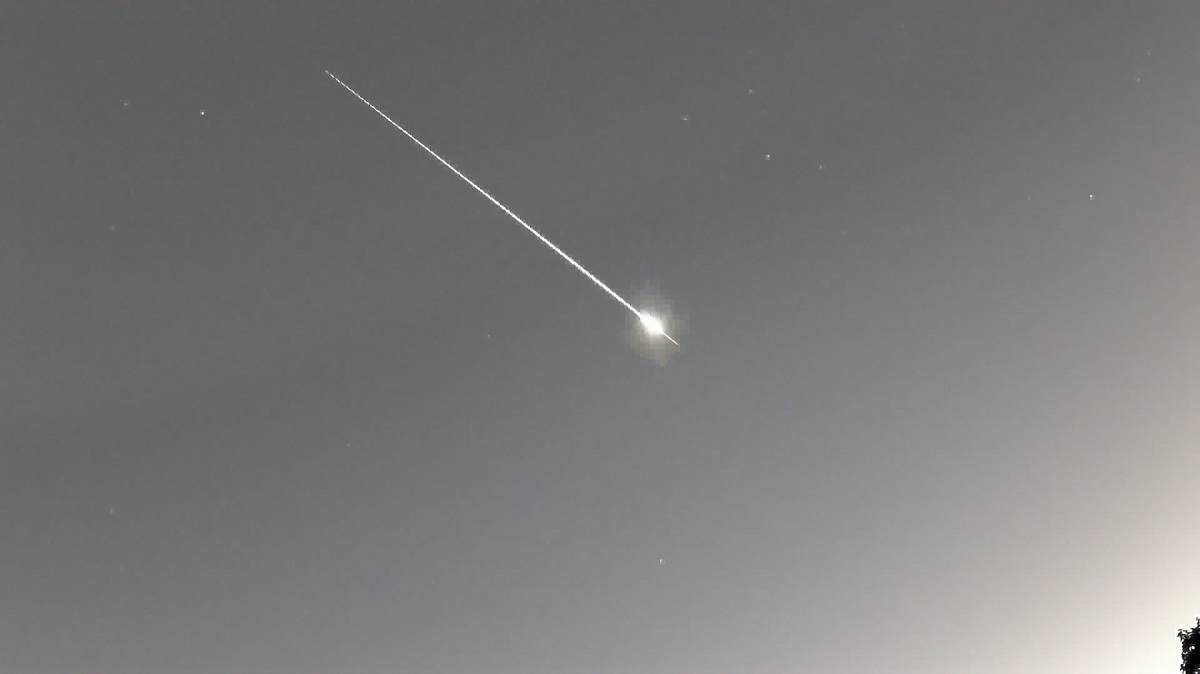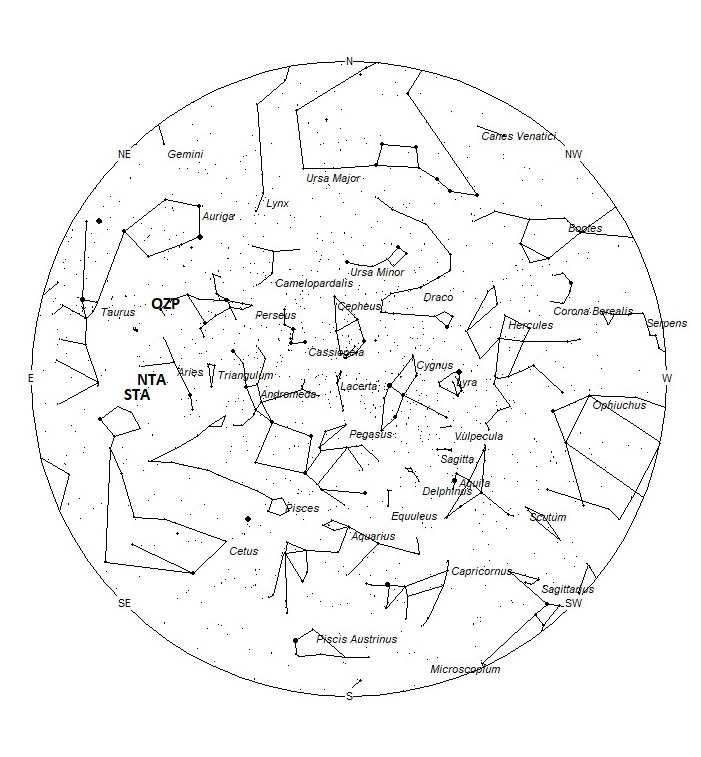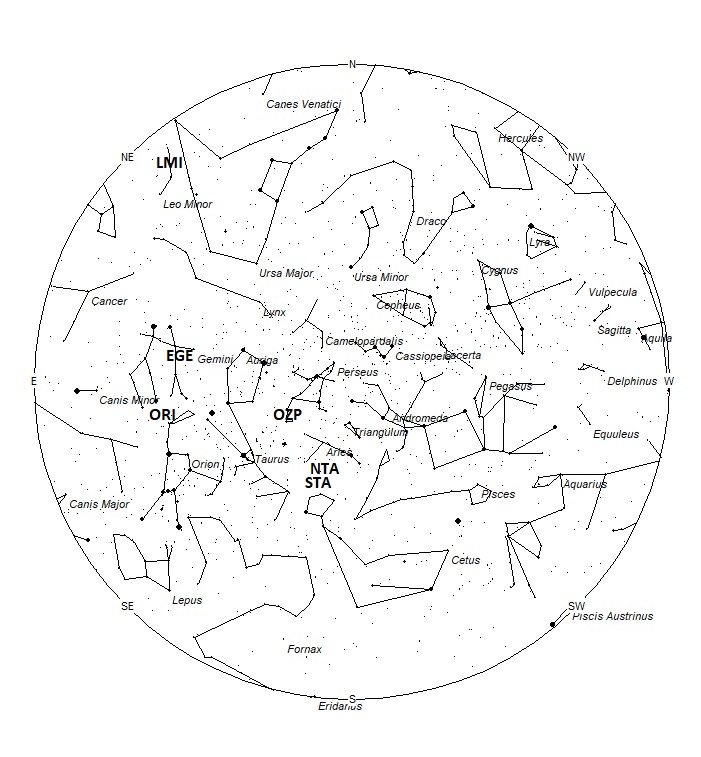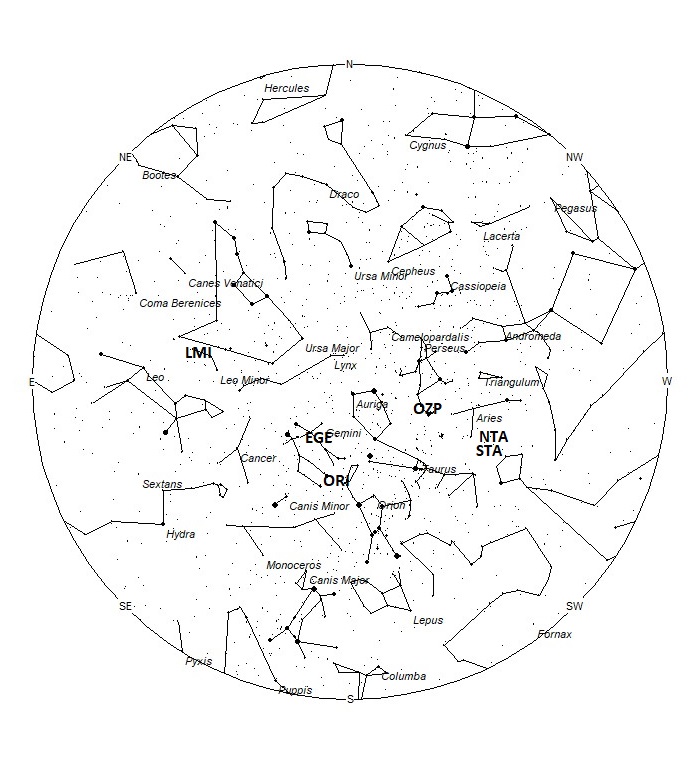 Jordan Ragsdale captured this brilliant fireball with a terminal flare using his AllSky Camera System on July 20, 2022, at 05:30 MDT (11:30 UT) from Eagle, Idaho, USA. ©Jordan Ragsdale
Jordan Ragsdale captured this brilliant fireball with a terminal flare using his AllSky Camera System on July 20, 2022, at 05:30 MDT (11:30 UT) from Eagle, Idaho, USA. ©Jordan RagsdaleDuring this period, the moon reaches its new phase on Tuesday October 25th. At that time the moon will lie near the sun and will be invisible at night. As the week progresses the waxing crescent moon will enter the evening sky but will be so thin and will set so early that it will not interfere with meteor observing. This weekend the moon will rise just prior to dawn and will not interfere with meteor observing. The estimated total hourly rates for evening observers this week should be near 5 as seen from mid-northern latitudes (45N) and 4 as seen from tropical southern locations (25S) For morning observers, the estimated total hourly rates should be near 25 as seen from mid-northern latitudes (45N) and 20 as seen from tropical southern locations (25S). The actual rates will also depend on factors such as personal light and motion perception, local weather conditions, alertness, and experience in watching meteor activity. Note that the hourly rates listed below are estimates as viewed from dark sky sites away from urban light sources. Observers viewing from urban areas will see less activity as only the brighter meteors will be visible from such locations.
The radiant (the area of the sky where meteors appear to shoot from) positions and rates listed below are exact for Saturday night/Sunday morning October 22/23. These positions do not change greatly day to day so the listed coordinates may be used during this entire period. Most star atlases (available at science stores and planetariums) will provide maps with grid lines of the celestial coordinates so that you may find out exactly where these positions are located in the sky. I have also included charts of the sky that display the radiant positions for evening, midnight, and morning. The center of each chart is the sky directly overhead at the appropriate hour. These charts are oriented for facing south but can be used for any direction by rotating the charts to the desired direction. A planisphere or computer planetarium program is also useful in showing the sky at any time of night on any date of the year. Activity from each radiant is best seen when it is positioned highest in the sky, either due north or south along the meridian, depending on your latitude. It must be remembered that meteor activity is rarely seen at the radiant position. Rather they shoot outwards from the radiant, so it is best to center your field of view so that the radiant lies at the edge and not the center. Viewing there will allow you to easily trace the path of each meteor back to the radiant (if it is a shower member) or in another direction if it is sporadic. Meteor activity is not seen from radiants that are located far below the horizon. The positions below are listed in a west to east manner in order of right ascension (celestial longitude). The positions listed first are located further west therefore are accessible earlier in the night while those listed further down the list rise later in the night.
These sources of meteoric activity are expected to be active this week.
.
The Northern Taurids (NTA) are active from a radiant located at 02:44 (41) +19. This area of the sky is located in central Aries, 4 degrees west of the 4th magnitude star known as Botein (delta Arietis). To best see these meteors, one should face southward near 02:00 LST. Maximum activity is not until November 12th so rates at this time should be near 1 per hour no matter your location. With an entry velocity of 29 km/sec., the average NTA meteor would be of medium-slow velocity.
The Southern Taurids (STA) are very complex and recent investigations have revealed two distinct components of this meteor shower. The first component represents the early and regular annual activity of Southern Taurids, and the latter component represents the main source of activity and is periodic. The early STA’s are active from September 28 through November 7 and peaks on October 17th. The main component of the STA’s is active from October 13 through December 2 and peaks on November 5th*. These two components lie only 5 degrees apart and would be difficult to distinguish by visual means. Therefore, we will list the mean position of these two sources which happens to be 02:48 (42) +13. This position lies in southeastern Aries, 3 degrees northeast of the 4th magnitude star known as mu Ceti. Like the NTA’s, to best see these meteors one should face southward near 02:00 LST. Rates at this time should be near 5 per hour as seen from the Northern Hemisphere and 4 per hour as seen from south of the equator. With an entry velocity of 27 km/sec., the average STA meteor would be of medium-slow velocity.
*The activity of meteor showers recorded by SonotaCo Net video observations 2007–2018, Masahiro Koseki, 2021, https://www.meteornews.net/2021/02/09/february-2021-special-issue-of-emeteornews-online/ Page 170
The October zeta Perseids (OZP) produced a short-lived outburst last year centered at 21:00 Universal Time on October 24th. The outburst only lasted three hours and was witnessed over Europe. If a repeat performance occurs in 2022, it is expected to peak near 3:00 UT on October 25th. This timing favors North America with the timing ranging from 11pm EDT to 8pm PDT on October 24th. Note that this occurs on the Monday evening October 24th for observers located in North America. The eastern half of North America is favored over the west due to a higher radiant location from that area. The radiant is located at 03:53 (058) +34, which is located in southern Perseus, 3 degrees northwest of the 3rd magnitude star known as zeta Persei. Last year a total of 14 bright meteors were recorded on video cameras operated by the Global Meteor Network*. Undoubtedly there were many more to be seen. If a repeat performance occurs, no matter your location, it would be best to face toward the northeast at the times mentioned above. Other areas in the Northern Hemisphere are encouraged to also try and verify any activity from this source on the nights of October 23-26. At 48km/sec., most of these meteors would possess medium-swift velocities.
*October zeta Perseid meteor shower (OZP #1131), posted by Denis Vida, Global Meteor Network, https://www.meteornews.net/2021/10/28/october-zeta-perseid-meteor-shower-ozp01131/ Accessed 20 October 2022
The Orionids (ORI) are active from September 26 through November 22, with maximum activity occurring on October 21st. The radiant is currently located at 06:27 (097) +16, which places it on the Orion/Gemini border, 3 degrees southwest of the 2nd magnitude star known as Alhena (gamma Geminorum). To best see these meteors, face toward the south during the last hours prior to dawn. Current rates are expected to be near 10 per hour, no matter your location. With an entry velocity of 66 km/sec., the average ORI meteor would be of swift velocity. Also see: https://www.imo.net/viewing-the-orionid-meteor-shower-in-2022/
The epsilon Geminids (EGE) are active from a radiant located at 07:08 (107) +27. This area of the sky lies in central Gemini, 4 degrees south of the 4th magnitude star known as (tau Geminorum). To best see these meteors, face toward the east during the last dark hour prior to dawn. These meteors are active from September 27 through November 8, with maximum activity occurring on October 19. Hourly rates at this time should be near 1 as seen for the Northern Hemisphere and less than 1 per hour as seen from south of the equator. With an entry velocity of 70 km/sec., the average EGE meteor would be of swift velocity.
The Leonis Minorids (LMI) are active from October 13th to November 3rd, with maximum activity occurring on October 21st. The radiant is located at 10:44 (161) +38, which places it in northeastern Leo Minor, 3 degrees northeast of the 4th magnitude star known as beta Leonis Minoris. These meteors are best seen by facing toward the northeast during the last couple of hours prior to dawn. This shower is better for observers situated in the Northern Hemisphere where the radiant rises far higher into the sky before the start of morning twilight. Current hourly rates would be near 1 as seen from the Northern Hemisphere and less than 1 as seen from south of the equator. At 62km/sec., the average Leonis Minorid is swift. From my personal experience this minor shower produces a high proportion of bright meteors.
Sporadic meteors are those meteors that cannot be associated with any known meteor shower. All meteor showers are evolving and disperse over time to the point where they are no longer recognizable. Away from the peaks of the major annual showers, these sporadic meteors make up the bulk of the activity seen each night. As seen from the mid-Northern Hemisphere (45N) one would expect to see during this period approximately 10 sporadic meteors per hour during the last hour before dawn as seen from rural observing sites. Evening rates would be near 3 per hour. As seen from the tropical Southern latitudes (25S), morning rates would be near 7 per hour as seen from rural observing sites and 2 per hour during the evening hours. Locations between these two extremes would see activity between these listed figures.
The list below offers the information in tabular form. Rates and positions are exact for Saturday night/Sunday morning except where noted in the shower descriptions.
| SHOWER | DATE OF MAXIMUM ACTIVITY | CELESTIAL POSITION | ENTRY VELOCITY | CULMINATION | HOURLY RATE | CLASS |
| RA (RA in Deg.) DEC | Km/Sec | Local Summer Time | North-South | |||
| Northern Taurids (NTA) | Nov 12 | 02:44 (41) +19 | 29 | 02:00 | <1 – <1 | II |
| Southern Taurids (STA) | Nov 05 | 02:48 (42) +13 | 27 | 02:00 | 5 – 4 | II |
| October zeta Perseids (OZP) | Oct 25 | 03:53 (58) +34 | 48 | 03:00 | ? | IV |
| Orionids (ORI) | Oct 21 | 06:27 (097) +16 | 66 | 05:00 | 10 – 10 | I |
| epsilon Geminids (EGE) | Oct 18 | 07:08 (107) +27 | 70 | 06:00 | 1 – <1 | II |
| Leonis Minorids (LMI) | Oct 24 | 10:44 (161) +38 | 62 | 09:00 | 1 – <1 | II |
Class Explanation: A scale to group meteor showers by their intensity:
- Class I: the strongest annual showers with Zenith Hourly Rates normally ten or better.
- Class II: reliable minor showers with ZHR’s normally two to ten.
- Class III: showers that do not provide annual activity. These showers are rarely active yet have the potential to produce a major display on occasion.
- Class IV: weak minor showers with ZHR’s rarely exceeding two. The study of these showers is best left to experienced observers who use plotting and angular velocity estimates to determine shower association. These weak showers are also good targets for video and photographic work. Observers with less experience are urged to limit their shower associations to showers with a rating of I to III.







 You saw something bright and fast? Like a huge shooting star? Report it: it may be a fireball.
You saw something bright and fast? Like a huge shooting star? Report it: it may be a fireball.  You counted meteors last night? Share your results with us!
You counted meteors last night? Share your results with us!  You took a photo of a meteor or fireball? You have a screenshot of your cam? Share it with us!
You took a photo of a meteor or fireball? You have a screenshot of your cam? Share it with us!  You caught a meteor or fireball on video? Share your video with us!
You caught a meteor or fireball on video? Share your video with us!